Neighbors Fear a Subdivision Will Cause Additional Flooding In Heathcote
- Details
- Written by Joanne Wallenstein
- Hits: 2547
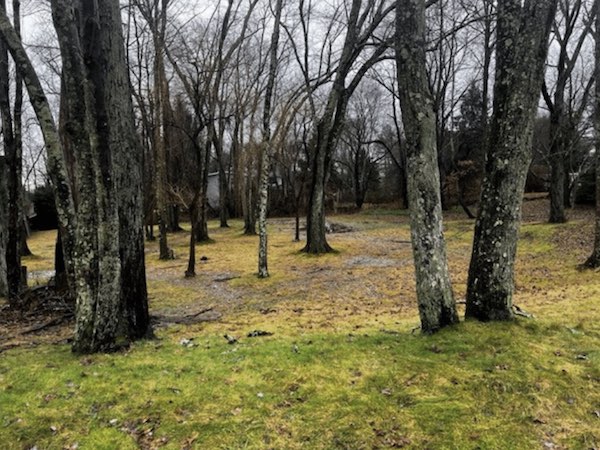 Though the Scarsdale Trustees imposed a moratorium on some land use applications earlier this month, several projects that were already in the works are still under consideration as the applications were filed before the moratorium was imposed.
Though the Scarsdale Trustees imposed a moratorium on some land use applications earlier this month, several projects that were already in the works are still under consideration as the applications were filed before the moratorium was imposed.
At a lengthy meeting on January 31, the Planning Board held a hearing on a proposal for a
subdivision at 46 Lincoln Road and 101 Carthage Road that would covert two lots into three. The Board spent two hours questioning an engineer and the developer’s attorney about plans to relocate an underground watercourse, remove 44 trees and build a third house in an open lot between the two existing lots.
The hearing had been rescheduled as insufficient notice of the meeting date was given when the Village newspaper suddenly ceased publication.
Representing Developer Raj Krishnan, attorney Lucia Chiocchio of Cuddy and Feder explained that the house at 101 Carthage Road would be removed and two new homes would be built. There is an application pending with the Committee for Historic Preservation to take down 46 Lincoln Road and if passed, a new home will be built there as well. All three lots meet the minimum lot size requirements. The three new homes would face Carthage Road and retention basins would be buried in the front yards.
In order to regrade the properties and improve drainage, the developer is seeking approval for “land disturbance within the adjoining property buffer.”
The plan includes the relocation of an underground water pipe that gathers water from surrounding properties and catch basins on 46 Lincoln Road. According to the attorney, the watercourse was original an open stream but was buried at some point between 1954 and 1976.
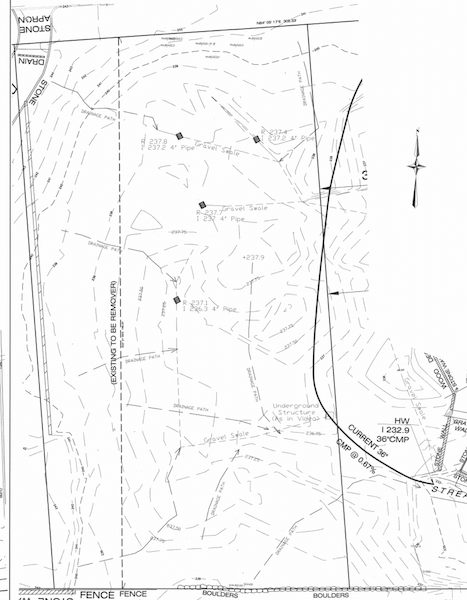 Applicants are proposing to relocate an underground stream that runs through the property (the dark black line) to the Village Right of Way along Lincoln and Carthage RoadsThe engineer explained plans to move the water course into the Village right of way along Carthage and Lincoln Roads and to make it a part of the Village’s drainage infrastructure. The new pipe would be 42 inches in diameter and Senor said it would reduce the velocity of water coming off the property by 35%. Senor said, “The new stream would be wider and rougher and slow down the water velocity.”
Applicants are proposing to relocate an underground stream that runs through the property (the dark black line) to the Village Right of Way along Lincoln and Carthage RoadsThe engineer explained plans to move the water course into the Village right of way along Carthage and Lincoln Roads and to make it a part of the Village’s drainage infrastructure. The new pipe would be 42 inches in diameter and Senor said it would reduce the velocity of water coming off the property by 35%. Senor said, “The new stream would be wider and rougher and slow down the water velocity.”
According to Village Engineer David Goessl, “The Village Board would need to approve a resolution to put the watercourse in the Village right of way.”
Questioned as to why the property appears to be very wet and “ponds” during rainstorms, Senor claimed that a series of catch basins on the property were not maintained and that the existing pipe was corroded. The new home would be built on the site of these catch basins so he claimed there would no longer be an issue.
The engineer fielded additional questions about the plan. Since there would be very little distance between the driveways of the two new homes would there be a median for planting? Given the 8 foot difference in elevation between the proposed new homes, Senor explained that a retaining wall that rises to a height of four and a half feet would be built between the two. Goessl asked if the driveway would be wide enough for a car to turn around and get into the garage bays. About the disturbance of the buffer, Senor pointed out that since the properties are adjacent, some of the disturbance would be between the two new properties, but pointed to other areas abutting existing neighbors where regrading would need to be done in the buffer area.
Landscape Architect Walter G. Nestler explained that the property includes 98 trees and they plan to remove 44 trees and retain 54 trees. Some trees are coming out due to the rerouting of the stormwater pipe. They will replace the 44 trees with 67 trees. About the canopy trees he said, we will replace some of them with natives, but they will not grow to the height of the current ones “in my lifetime.” He said some of the trees that will be removed are invasive or dead.
Residents waited over two hours to comment and some left before they had the chance to do so. They questioned the engineer’s plans to redirect the water and presented a different picture of the current water issues that already plague their streets and homes.
Jay Cannell of 121 Carthage Road read a letter from Eric Tepper of 26 Lincoln Road, which is five houses upstream from 46 Lincoln Road. Tepper said he has lived on Lincoln Road for 21 years but there has been considerable flooding only in the past five years. He said he experienced $40,000 in damage to his basement and his gravel driveway was washed away. He said, “This was despite assurances that subdivisions would not affect my house.” Referring to the current proposal he said, “I see no evidence that we will not have incremental water damage. The property is below street level and has its own water issues. I do not see any benefit to the community. The only benefit is the monetary value to the developer.”
 A preliminary rendering of the three proposed homes on Lincoln Road.Canell said he has been on Carthage Road since 2006 and spent $700,000 addressing his water issues. About the proposed development he said, “The three houses are going to look ridiculous – look at the house on Carthage Road -I am amazed that it is legal to have a house that close to the road….. What is going to happen to the houses downstream that they are tapping into? I am the second house in from the left from Mamaroneck Road (121 Carthage Road). All the water comes downhill. Now you are taking more water and putting it into the current system. You are allowing too many houses to be built. The problem in Scarsdale is there is too much water overflowing into the existing houses. We didn’t have floods when I was growing up here. If you add new developments – what about the damage you will do to other peoples’ houses?”
A preliminary rendering of the three proposed homes on Lincoln Road.Canell said he has been on Carthage Road since 2006 and spent $700,000 addressing his water issues. About the proposed development he said, “The three houses are going to look ridiculous – look at the house on Carthage Road -I am amazed that it is legal to have a house that close to the road….. What is going to happen to the houses downstream that they are tapping into? I am the second house in from the left from Mamaroneck Road (121 Carthage Road). All the water comes downhill. Now you are taking more water and putting it into the current system. You are allowing too many houses to be built. The problem in Scarsdale is there is too much water overflowing into the existing houses. We didn’t have floods when I was growing up here. If you add new developments – what about the damage you will do to other peoples’ houses?”
About 46 Lincoln Road he said, “That area was a lake – they built it over water. Is the builder willing to cover future losses? Is the town going to take responsibility. Why are we building three houses? Money. … We are going to proceed with legal action if we have adverse effects. I love the term 100-year storm – we have had 9 of them. This should not be approved. The water can’t go anywhere.”
Diana Hurwitz lives on Fayette Road behind 46 Lincoln Road. She said, “I object to any work being done in the property buffer behind my house. The water has become a bigger issue for us and our neighbors. Does not make sense to take land where there is ponding and build on it? There have been two homes there separated by a damp, area. Building there will compromise the neighbors’ properties. There has been no improvement to our stormwater system and we continue to build. If the Village foolishly agrees to this – is the Village going to be responsible for the increased flooding? Senor worked on a subdivision across the street and both homeowners have had 100’s of thousands of flooding in their homes. If greed wins and this is approved I believe there should be an independent civil engineer, and a bond to reimburse neighbors.”
Jason Yellin of 104 Carthage Road said I lived here since 2012 on a subdivision. The home was constructed in 2008. I would be across the street from the relocated pipe – we will be above it.
But what’s going to happen downstream? The water is getting higher and higher.
I am worried about Lincoln and the bottom of Carthage. Focus on the downstream impacts.”
Nelson Soares of 49 Lincoln Road said, “The stream goes underneath Lincoln and between 47 and 49 Lincoln Roads where it overflows. We have had sewage issues. In the last few years this has happened many times. We have had more problems in the last 5-10 years.”
Samuel Blakely of 47 Fayette Road said, “Every time it rains the storm drains flood. The water collects in the open lot on Lincoln Road – and releases over time. If they build a house there, there won’t be a place for the water to collect. This would cause the rain to go right into my yard – there would be more water storage to catch and release. My basement is flooded because of new construction.”
Marcia Helbling of 42 Fayette Road spoke about neighborhood character. She said, the charge of this board is to “Impose design conditions to ensure that buildings are built in harmony with the community. I live next door to 44 Fayette Road – it is in size and color non-conforming. It is very upsetting to live next door to that. This builder has lost all credibility that he will build something that conforms.”

Jack Miller of 45 Fayette Road said, “I didn’t see the notice until Thursday.” He showed a series of historic village maps that included a pond at the present site of the Heathcote School and an open watercourse that ran from Lincoln Road to Crossway Field. He said, “there is a rare opportunity to restore an historic waterway … There is a stream that goes from 50 Lincoln Road to the firehouse.” In a letter to the Planning Board he said, “The thought of re-routing a watercourse off its long-time course could be catastrophic. To people who live in the area.”
Discussing the house he said, “46 Lincoln is a Usonian style house modelled after Frank Lloyd Wright’s Falling Water. The open stream was a feature of the house. The stream is still there but sometime in the 1970’s it was covered over. Relocating this stream makes this a tricky site. I know how I would vote on this if I was in your shoes. Three houses here would be detrimental to the neighbors.”
Jessica Bandel said she lives “adjacent to 101 Carthage Road.” She said, “We all have to live with the flooding. I do not consent to any work in the property buffer. She urged the Planning Board to “make the ethical decision.”
CNC Announces Candidate Slate for Election on March 19
- Details
- Written by Joanne Wallenstein
- Hits: 2175
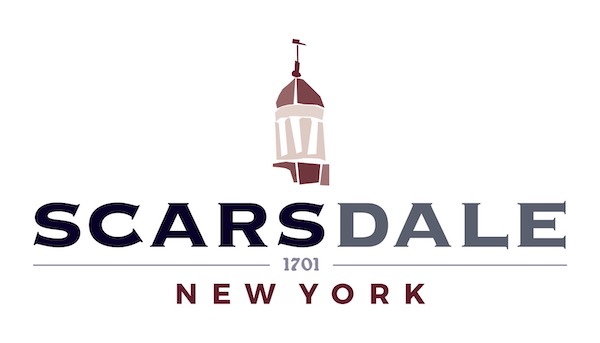 The Citizens Nominating Committee (CNC) announced January 18 the candidates it selected for the Scarsdale Citizens Non-Partisan Party slate for the following offices:
The Citizens Nominating Committee (CNC) announced January 18 the candidates it selected for the Scarsdale Citizens Non-Partisan Party slate for the following offices:
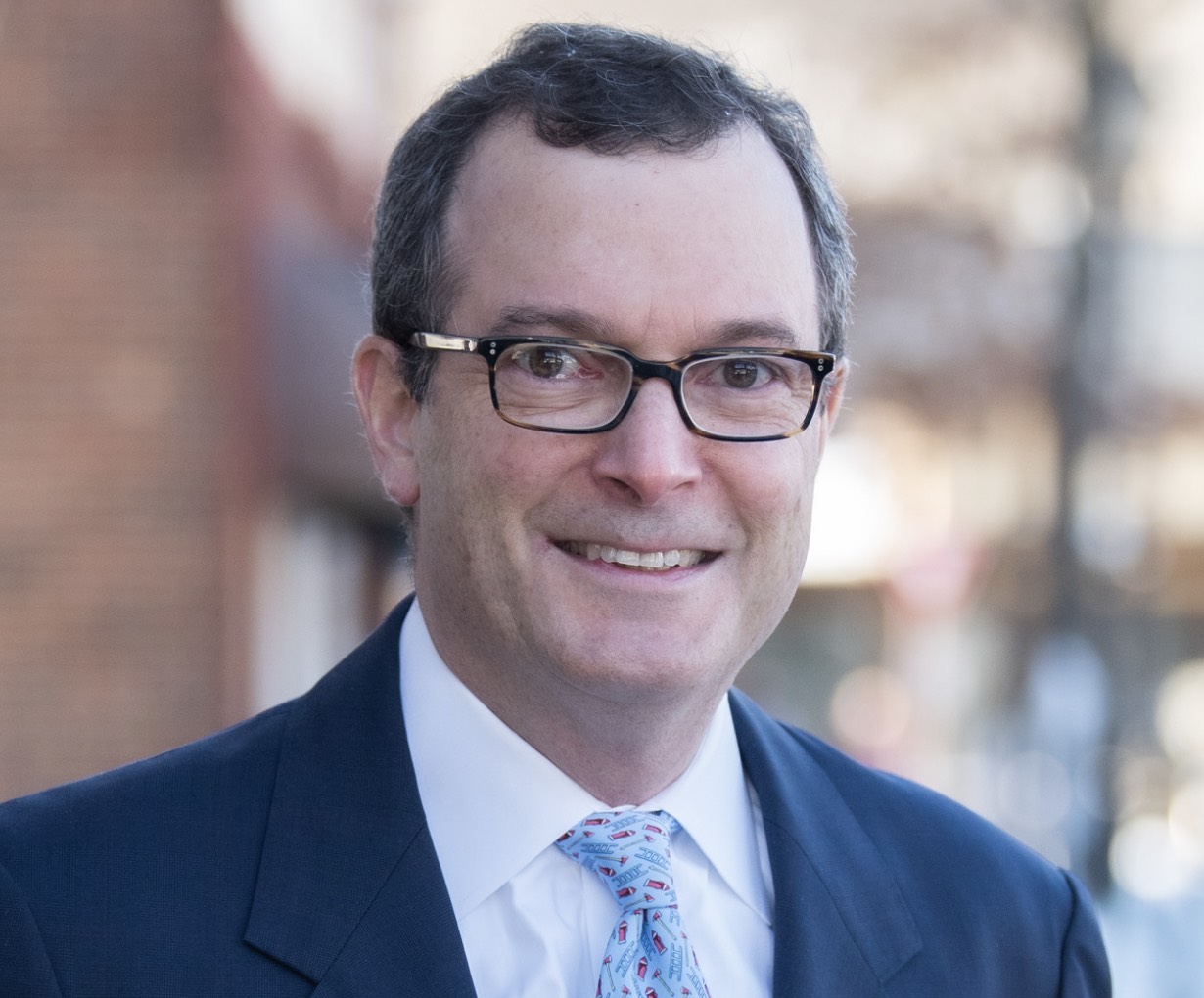 Ken Mazer is running for a second term for Village TrusteeTrustees: Ken Mazer of 47 Church Lane, a Scarsdale resident for 27 years; Jeremy Gans, of 45 Harvest Drive, a 16-year resident; and Jeremy Wise of 14 Boulder Brook Road, a 33-year resident.
Ken Mazer is running for a second term for Village TrusteeTrustees: Ken Mazer of 47 Church Lane, a Scarsdale resident for 27 years; Jeremy Gans, of 45 Harvest Drive, a 16-year resident; and Jeremy Wise of 14 Boulder Brook Road, a 33-year resident.
Michael Curti of 70 Brown Road, Scarsdale, was nominated to run for Village Justice. Judge Curti became Acting Village Justice in November 2023 when Cynthia Dunne resigned. He was then appointed Village Justice in December 2023 to fill the vacancy and finish the term through March 2024. Prior to this Judge Curti served as assistant village justice under Justice Dunne.
The general election will take place Tuesday, March 19, at the Scarsdale Public Library, 54 Olmsted Road in the Scott Room. Voting hours will be from 6:00 am to 9:00 pm.
 Jeremy Wise was nominated to run for Village Trustee.Jared Stern served as chair and Mary Pat Jones served as vice chair of the CNC. In addition to candidates for village office, the CNC elected Raju Sitaula as chair and Scott Harris as vice chair for next year’s CNC. The CNC also elected Ralph Geer to serve as vice chair of the Procedure Committee.
Jeremy Wise was nominated to run for Village Trustee.Jared Stern served as chair and Mary Pat Jones served as vice chair of the CNC. In addition to candidates for village office, the CNC elected Raju Sitaula as chair and Scott Harris as vice chair for next year’s CNC. The CNC also elected Ralph Geer to serve as vice chair of the Procedure Committee.
Starting in late November 2023, the CNC searched for potential candidates and then conducted extensive diligence. While deliberations and reference  Jeremy Gans is running for a second term for Village Trustee.conversations are not shared publicly, the CNC considered and carefully researched the background, experience, and qualifications of each candidate and engaged in significant deliberation. We thank the CNC members for their hard work and diligence in selecting this strong slate of candidates.
Jeremy Gans is running for a second term for Village Trustee.conversations are not shared publicly, the CNC considered and carefully researched the background, experience, and qualifications of each candidate and engaged in significant deliberation. We thank the CNC members for their hard work and diligence in selecting this strong slate of candidates.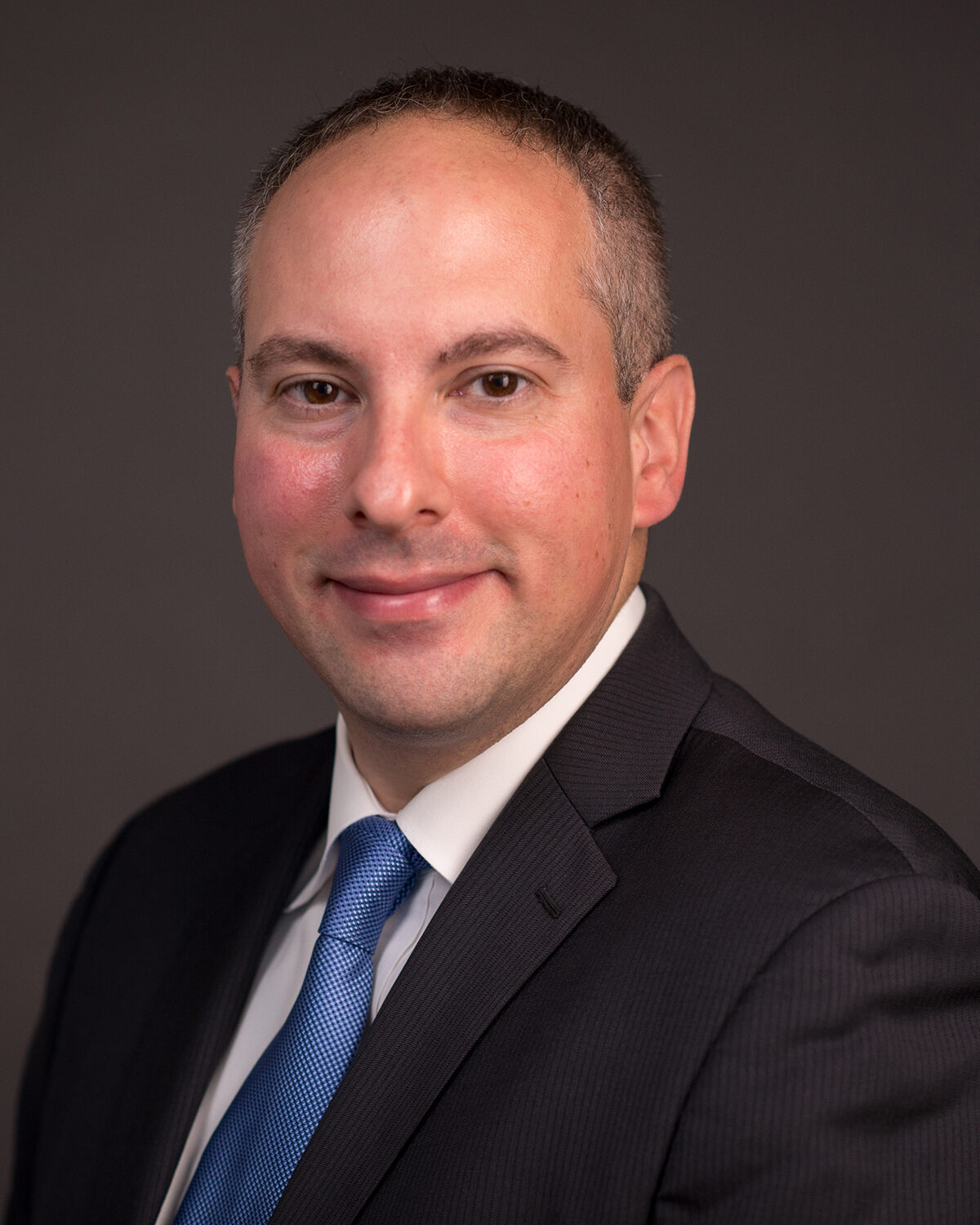 Village Justice Michael Curti
Village Justice Michael Curti
Trustees Post Revised Draft of Proposed Building Moratorium
- Details
- Written by Joanne Wallenstein
- Hits: 1648
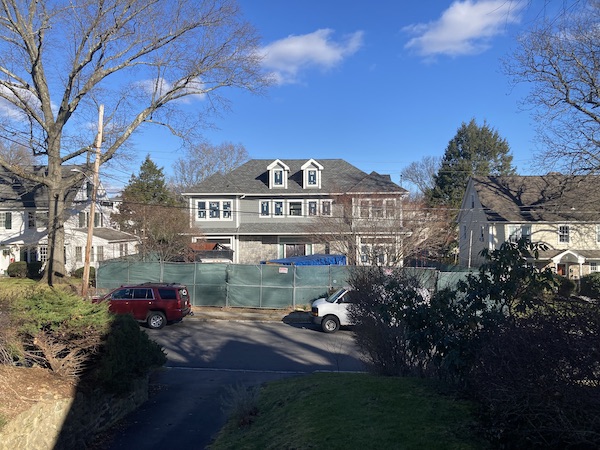 (Updated 1-4-24) The Scarsdale Village Board has released a revised draft of the proposed building moratorium, easing some of the restrictions in the original draft.
(Updated 1-4-24) The Scarsdale Village Board has released a revised draft of the proposed building moratorium, easing some of the restrictions in the original draft.
Terms outlined in the new draft will permit some renovations and building to proceed but with restrictions on the floor area coverage, building coverage and lot coverage to limit the size of projects and their impact on neighboring homes. The revised code rolls back the effective date of the moratorium from November 14, 2023 to December 19, 2023 which means that any applications filed before December 19 can proceed through the former application process.
For those wishing to renovate while not demolishing an entire house, the new language would assign the application to an interim review board for consideration. If passed it would be allowed to go before any necessary boards. The revision says, “For any demolition permit for less than a substantial part of a building (as defined in Section 182-3(E)(1) of the Village Code) or for a building permit, an applicant shall demonstrate to the satisfaction of the Interim Review Committee “three members with architectural or historic building experience, to be appointed by the Mayor) that any proposed exterior alteration will not impact the special character or special historical, cultural or aesthetic interest of the building proposed to be altered.”
These new terms address concerns of residents wishing to do additions or renovations of their homes, while limiting home size and bulk but also address concerns of those who were calling for limitations on teardowns and the size of new builds.
The law scales back the allowable square footage and coverage of projects to be approved during the moratorium as follows:
“Any application for new construction or an addition that increases the bulk or footprint of a building that demonstrates to the satisfaction of the Village Planner, Village Engineer and Building Inspector all of the following:
a. The proposed FAR, Building Coverage and Lot Coverage are less than 95%, 95% and 90%, respectively, of that permitted under the existing Zoning Code;
It also increases the required setbacks:
b. The proposed side yard setback shall be no less than the following for each Zoning District, (with any FAR Bonus permitted pursuant to Section 310-104 being measured from the revised set back listed below):
i. AA1 Zoning District: 33 feet;
ii. A1 Zoning District: 22 feet;
iii. A2/A2a Zoning District: 16.5 feet;
iv. A3 Zoning District: 12 feet;
v. A4 Zoning District 11.5 feet; and
vi. A5 Zoning District: 11 feet
Subdivision applications could go to the Planning Board but any project would have to be based on the reduced setbacks and other zoning limits as specified in paragraph 7L.
Demolitions however are barred during the six month period. The law is very clear on this provision and says, "No board, committee, agency, department, officer, employee, consultant, or agent of the Village of Scarsdale shall accept for review, continue review, hold a hearing on, continue a hearing, or make any decision upon any application for approval for a building permit or demolition permit to enlarge, construct, or demolish a one-family residential dwelling, accessory building or structure. All time periods set forth under state law or the Village Code for the processing and making decisions and all aspects of applications for building permit or demolition approval as indicated herein are hereby suspended and stayed while this local law is in effect.
It also allows for hardship applications.
The language can be reviewed here.
The Mayor previously said that a public hearing and a vote would be held at the Board of Trustees first meeting of the year on Tuesday January 9, 2024.
Board Enacts Six Month Building Moratorium in Scarsdale
- Details
- Written by Joanne Wallenstein
- Hits: 3669
 After much debate, discussion and two public hearings the Scarsdale Board of Trustees passed a resolution calling for a six-month building moratorium at their meeting on January 9, 2024. The moratorium calls for modest reductions in the allowable floor area ratio (FAR) of homes, building coverage and lot coverage and bars whole home demolitions during the six-month period. It continues to allow renovations that do not exceed the maximum size and coverage regulations and subdivisions that meet the temporary guidelines.
After much debate, discussion and two public hearings the Scarsdale Board of Trustees passed a resolution calling for a six-month building moratorium at their meeting on January 9, 2024. The moratorium calls for modest reductions in the allowable floor area ratio (FAR) of homes, building coverage and lot coverage and bars whole home demolitions during the six-month period. It continues to allow renovations that do not exceed the maximum size and coverage regulations and subdivisions that meet the temporary guidelines.
The original resolution, calling for a more complete halt to applications, was modified after the Board received feedback from the community. The approved version permits renovations and subdivisions but cuts back the size of homes, requiring a 5% cut in the floor area ratio, a 5% cut in building coverage and a 10% cut in total lot coverage.
During this time, the Village will consider amendments to Village land use code and processes to address home bulk, neighborhood character, flooding and tree removal. At the December 26, 2023 meeting, the Board retained BFG Planning to review the Village’s zoning code and make recommendations.
Explaining his vote in support of the moratorium, Deputy Mayor Randy Whitestone summarized many of the concerns that led the Village to this moment. He said:
“I don’t approach this vote lightly. I have spent time thinking about the impact that a temporary moratorium will have on the community – as well as the impact of not having a moratorium.
For me, the key considerations are:
-What is the most effective way to ensure that any code changes and adjustments to our land use procedures are the product of careful objectives-based analysis and subject-matter expertise. We’ve enacted various code changes in recent years, but they haven’t addressed the issues we’re discussing – and trying to solve for – in a holistic way.
-How can we ensure that our housing stock continues going forward to meet the needs of our families in ways that account for the needs of neighbors and the broad community and the character that has long defined our village in a park.
-How can we make sure village staff have the right tools at their disposal to deal with the amount and pace of development and the resulting impacts on our infrastructure.
-How do we ensure that our land use boards have the necessary interconnectivity, training, and division of responsibilities – avoiding loopholes that advantage one group over another -- to deal with the at times rapid-fire pace of applications.
Finally, what approach to local land use regulation best serves the most people, because my dedicated colleagues and I serve the interests of the entire community not any specific group, or ourselves.
Change is a constant, and Scarsdale through the years has proved adaptable, vibrant, and dynamic; just look at the rebound from Covid! But our village has also always tried to be the best version of itself, defined by a community mindset and sense of public spirit. In line with this, I believe a brief and somewhat limited “time out” – importantly, both finite in terms of time and limited in scope – gives us a chance to undertake bringing our long-run code in line with real-world outcomes and best practices to ensure that they align with the community's long-term vision. The larger point is that this is not about standing still, this is about moving forward in a thoughtful way.”
The call for a moratorium originated with Edgewood resident Jim Detmer who fought the demolition of a treasured home in “The Woods” section of Scarsdale and the plan to subdivide the property. He rallied neighbors to object and also posted a petition calling for a reconsideration of Village policy.
Commenting on the Board’s 6-1 vote to approve the moratorium Detmer said, “The moratorium allows the BOT, with the help of consultants and the community, the space and time to effectively address important local land use and building code issues. It is critical that the Board discuss, draft and enact changes in zoning and land use that reflect the values of the citizens of Scarsdale. The amended moratorium that was approved last night is an important initial compromise. Neither side got everything they wanted. Obviously, there is a lot of work to be done and a tight timeline to consider. We would do well to help and assist the Board in their effort to evaluate these problems, working towards meaningful long-term solutions that reflect the principles and values of Scarsdalians.”
The resolution was highly controversial. The Scarsdale Planning Board issued a memo against it, and builders, architects, realtors and tradesmen fought hard to prevent its passage.
The development community argued that the move would hurt Scarsdale’s economy, reduce property values, impact earnings for the construction industry, realtors and tradesmen and deter buyers and sellers. About flooding, they said that the Village’s aging infrastructure, not new construction, was the issue and that the Village should invest in upgrading the drainage.
Residents who supported the moratorium asked trustees to examine ways to limit the bulk of new homes, prevent the teardown of neighborhood homes, save trees and address flooding. Susan Douglass, a former president of the Scarsdale Forum called in to the meeting and said, “I am dismayed by the huge, oversized homes being built. A thoughtful pause on what we are trying to achieve would be helpful. I think there is a silent majority of people who want the board to take a pause to think about our infrastructure and how can we support more homes, larger homes and protect our trees. Let’s just be careful – once everything is gone we can’t put it back. Be mindful and listen and take care of our valuable resources before they are gone.”
Rain and winds may have deterred some from coming to Village Hall for the hearing, but there was a sizable contingent of builders, architects, realtors and an engineer at Village Hall and more commented via Zoom. Many echoed what they said at the December 19 hearing, but here is a sampling of their remarks. You can watch a recording of the entire hearing at Scarsdale.com.
Rob Frangione an engineer from CT said, “(The moratorium) will do nothing to stop the flooding in town. Some are blaming rapid overdevelopment. In Scarsdale all runoff needs to be considered. After development there is less runoff than before. I believe it’s a problem with the Village’s drainage system – the Village needs to invest in its drainage infrastructure. It is easy to blame the drainage woes on development.”
Architect Roz Young said she “supports code review but not a moratorium.” She asked a series of questions about which rules would apply to which projects and was told that an FAQ from the Building Department would be posted to answer those questions.
Bana Choura, also a local architect, said, “I still object to the moratorium.” She said that the “5% reduction in the FAR could mean the loss of 200 square feet, or an extra bedroom on homes on smaller lots.”
Boning Liu of 45 Jefferson who is an engineer said, “Halting development alone may not address flooding. We need a comprehensive drainage plan to address climate change. Consider the bigger picture.”
Raj Krishnan, a local developer and physician said, “My wife and I have grown to be aware of socially conscious building. We are builders and Scarsdale has offered a wonderful opportunity to do this. We are subdividing to enhance the texture and diversity of Scarsdale. We all live in a subdivision. The moratorium is a penalty against builders and the public and those who want to move here. People want to come here and live in new houses. It would be a travesty to stop development in Scarsdale. These new houses increase the revenues. Let’s take those funds and put them into infrastructure improvements.”
Lee Handler, a builder who now lives at 17 Morris Lane said, “I used to live at 14 Lebanon Road and I had a sump pump. I got a violation notice from the Village – I put in a dry well and nothing was wet after that. It solved my water problem. I understand that people don’t want to spend money on things you can’t see. There is no water issue in the homes that I build. If your house doesn’t have an adequate draining system you are going to have a water problem.If you implement the 5% reduction you are going to devastate Edgewood. The housing values are going down. I think the Village should offer incentives to put in drainage.”
Builder Eilon Amidor said, “It is a bad mistake to vote on the moratorium. Most of the speakers who came today were mostly against the moratorium. A moratorium can devastate the Scarsdale real estate. Why don’t we make a referendum. It is a big change to just be voted on by the Trustees. You are talking about losing half a billion in real estate. This needs to be voted on by the whole Village of Scarsdale. Only 100 people started the movement. Make it to the entire Village and I am sure you are going to find out that people want not to lose money. Every new construction takes care of water. If you deem a house is historical you can allow people to build it the same way – the same material. No reason to cause more economical hardship. People who want to sell their houses are going to have a hard time selling it.”
Speaking in support of the moratorium Maura Lee said, “I think there is a strong majority who are not speaking because it’s not in their backyard. Many are dismayed by the building that is going on. The green space that we’re taking away, cannot be good. I have lived in Scarsdale my whole life. We are knocking down Scarsdale and building many of the same homes and I do support the moratorium.”
Jeff Wang of Ferncliff Road said, “In the past few years three new houses were built around my house. One is elevated. A huge house replaced a small house. They pump water out of their basement, down their driveway to a small drain on my street and flooded the street and my basement. Everybody is a victim.The building department did not make sure that the water was properly drained.”
Anne Hintermeister felt that the resolution did not go far enough. She said, “Subdivision applications were wisely included in the initial moratorium resolution. “Rampant subdividing,” to quote the Scarsdale Inquirer editorial supporting the first draft, was among the concerns that led to the proposed moratorium. Building two houses in a lot previously occupied by a single house could double the negative “pervasive adverse impacts” described in the moratorium resolution—specifically large-scale tree removal, elimination of permeable surfaces, bulk, and loss of neighborhood character.
So I was surprised to see that the moratorium was revised to allow subdivision applications to continue subject only to the new FAR and coverage haircuts devised by the Board on each of the new houses in the subdivided property.
Even if the FAR and coverage “haircuts” in the new draft are sufficient to protect the community from pervasive adverse impacts from new and remodeled houses generally, why would you assume that replacing a home with two compliant houses will have no greater negative impact on stormwater, on tree removal, on neighborhood character?
The stakes are high. Pausing subdivision applications does not inconvenience residents. Pause them while the Board and the land use officials and the consultant devise a carefully considered plan to address them, including possible changes to the multiple board review process that the land use Chairs discussed at a work session last month.”
Ultimately, the resolution passed, with six trustees in favor and one opposed.
Trustee Ken Mazer said, "The first draft of the proposal limited all construction for six months. After back and forth with residents and people in the industry I believe a reasonable compromise has been reached to give us space to craft a land use policy that reflects current land use needs."
Explaining her vote, Trustee Dara Gruenberg said, "We are not going to make everyone happy. But I think ultimately we have found something that I feel comfortable voting in support of that is balanaced. I do feel comfortable because we have worked with land use experts and our village professionals on this moratorium proposal and we have a land use consultant lined up who is already working."
Trustee Karen Brew said, "This has been a difficult debate. I do think that as trustees we represent the entire community. And we have to vote in their interest. I think there are economic consequences that everyone suffers. I think a six month pause on the rapid building will allow us to make some modifications to do what’s best for the entire community so that the residents don’t bear the cost for development."
Trustee Jeremy Gans was the sole no vote and explained, “I agree a review is needed but I don’t support a moratorium. Our job is to set policy. In the past we have relied on consultants and land use board and staff. We have not engaged with staff on these questions. The outside consultant has not weighed in. Our planning board advised against it. Our zoning board chair wrote a memo advising against it. No board has been asked to comment. This is temporary it is not permanent. During the six-month period we will hear from consultants and land use boards and I wish that had happened before.”
Hearing on Proposed Moratorium Brings Record Crowd to Village Hall
- Details
- Written by Joanne Wallenstein
- Hits: 2961
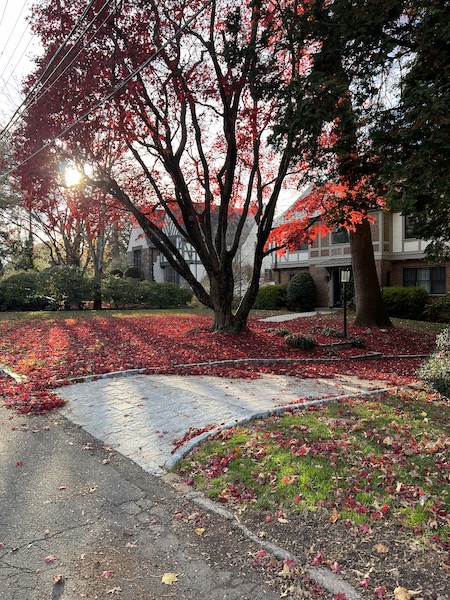 The prospect of a building moratorium in Scarsdale drew a full house to Village Hall on Tuesday December 12. The Village Board had proposed the moratorium at their November 14 meeting with the goal of giving the Village time to study zoning and flooding regulations, building code and the land use approval process. The resolution was proposed in response to residents’ complaints about tree loss, increased flooding, loss of neighborhood character and crowding due to subdivisions.
The prospect of a building moratorium in Scarsdale drew a full house to Village Hall on Tuesday December 12. The Village Board had proposed the moratorium at their November 14 meeting with the goal of giving the Village time to study zoning and flooding regulations, building code and the land use approval process. The resolution was proposed in response to residents’ complaints about tree loss, increased flooding, loss of neighborhood character and crowding due to subdivisions.
Prior to the hearing, Michelle Sterling from the Conservation Advisory Council gave an update on the Village’s tree policy which was adopted in 2018 and 2019. Several years ago the CAC did a study and found that Scarsdale has an approximately 50% tree canopy. However the data they have now shows that in 2021, 803 trees were removed with a permit but only 308 trees were planted to replace them. This count does not include the trees that were taken down without a permit. Sterling estimated that a total of about 1,000 trees are taken down each year. The CAC recommended stepped up enforcement measures to ensure that the trees were replaced. The report was timely as trees absorb water and stormwater mediation was a significant factor in the discussion about the proposed building moratorium.
Comments from the Mayor
Before opening the hearing on the proposed moratorium, Mayor Justin Arest thanked everyone for their letters and for coming and said that the draft legislation was created to begin the community conversation. He said no decision would be made before the end of the year and that the Board would consider revising the draft to limit its scope. An interim measure might be to limit construction to 85% - 90% of the current floor area ratio requirement, so if 10,000 square feet is now permitted, during the moratorium an 8,500 square foot home or addition could be built. In addition, there would be no hook ups to the stormwater system.
He added, “We must limit inflows to the stormwater system which is already overwhelmed.” He asked those who commented to make suggestions on how the code could be changed. He said that the Board plans to retain BFJ planning consultants to consider Scarsdale’s building and zoning code and said, “This review will be about the future. Passing incremental improvements may be satisfying, but we want to set up something that will work for decades.”
He noted that the Board had received two petitions: One with about 400 signatures in favor of the moratorium and another with 800 names against it. However the second petition only included first names and an initial for the last name. He asked for full names and addresses.
Comments from the Community
The first half of the comment period was dominated by many from Scarsdale’s thriving development industry, including architects, developers, tradesmen and realtors. They outlined the hardship the moratorium was already causing, including uncertainty among sellers and buyers, the prospect of decreased sales and eroding property values.
Most agreed that changes to the code were needed but contended that these changes could be made iteratively and that a moratorium should be avoided. They argued that newly constructed homes are required to include their own stormwater retention systems and they are drier than the older homes. They spoke on behalf of the tradesmen they employ and said they would have no work and risk their livelihoods.
In response to resident complaints about home bulk and crowding, architect Roz Young said, “I support new rules but not a moratorium. Updated codes on a new schedule can be set without a moratorium. It’s not fair to impose a moratorium because of a few egregious cases … If each board had clear guidelines they could follow them and there would be less bulk, more trees and more open space …. Give us new code today and we’ll design a beautiful Village for tomorrow.”
Some cited plans for renovations that did not increase the home footprint, such as the addition of a second floor, and the Mayor responded saying did not believe that these projects would be barred by the moratorium.
Realtor Zach Harrison reported that when Larchmont passed a moratorium in 2016 prices there declined 9.7%. In the same year in Scarsdale, where there was no moratorium, our prices increased 5.7% meaning there was a 15.4% difference between Larchmont which had a moratorium and Scarsdale which did not. Based on our average selling price of $2.36 million this year in Scarsdale, a similar 15.4% impact on the Scaradale market would result in about $360,000 in property value damage per Scarsdale homeowner." He said,"This is completely unnecessary and I ask that you reject this tonight.”
There were repeated comments about the spillover effect on other Scarsdale businesses. Realtor Dawn Handler said, “What about the plumbers and electricians who have built their businesses in Scarsdale. It might sound easy for them to go work in another town. The delis, food trucks; there is already concern on how this moratorium will affect them.”
Developer Eilon Amidor agreed. He said, “We can change the code without a moratorium. It is affecting the residents, workers and home prices. This will affect the cost of construction. Here we need a chain link fence on our job sites– it’s another $2,000. Other towns don’t have so many rules and regulations. It takes months to get a C of O here and that’s why it’s so expensive to build here.”
Paul Fontana, of the Cum Laude Group in Rye said he has “been working here for 23 years and is opposed to a moratorium.” He continued, “What is an intellectual problem for you is a real problem for me and my 42 employees. A moratorium is a blunt instrument. We can figure out the problem without shutting down the industry.”
Raj Krishnan said, “I am a doctor but we are builders and developers. I continue to provide opportunities for other families. We have built several homes at this point. These people share in that journey. It brings in diversity and I would hate to see that end. New homes bring diversity. The new homes are better and reduce our carbon footprint. We want more newer homes in Scarsdale. We employ a lot of people. We have tradesmen here and they will be significantly impacted. The aesthetic is changing. New families like that. It’s great to subdivide.”
Some younger residents with expanding families also expressed their objections. Kristen Cipriano of 81 Greenacres Avenue opposed restrictions, “especially on external renovations.” She said, “We need to expand our house. We planned with our architect to build this summer. It is unnecessary that renovations like the one I am planning can’t be accommodated.”
Cynthia Sanossian of 132 Brewster Road moved here five and a half years ago and three children with another on the way. She said, “We are working with an architect to plan the design. We will not max out our floor area ratio. The infrastructure is outdated and should be addressed. Drainage is a focus as we finalize plans for our addition/ A moratorium would solve nothing.”
Michal Levine of 54 Walworth Avenue said, “I moved here in 1967 with my parents. It is interesting when I find myself agreeing with Bob Harrison. I think the right thing is to not do the moratorium as drafted. It is too disruptive to many people. It is to blunt of an instrument.”
Also echoing objections to the moratorium were Bana Choura, You Zou, Joshua Lamberg, Randi Culang, Adrienne Price, Bob Harrison, Natalie Schroeter and Jeff Osterman.
However, some residents did speak in favor of the moratorium.
Mitch Seider said, “We support the moratorium. We have lived here for 22 years. It’s about community and balance.” About the previous speakers he said, “All of these people are here in their own best interest in the subdivision and tearing down of houses.” He quoted Jane Austen saying, “Tis because you are an indifferent person that your judgement might justly have such weight with me. If you could be supposed to be biased in any respect by your own feelings, your opinion, would not be worth having.” About the moratorium he said, “The negative impact would prevent the sale to a developer or a buyer who wants a new house on that property. There is nothing inherently wrong with restrictions. I could tear down my house and build a 3-story apartment building, but I am not allowed to do that.”
Mary Beth Evans of 16 Edgewood Road spoke in support of the moratorium. She said, “Our existing village code is failing to preserve the Village’s architectural character and scale and to maintain a Village in a Park. The development threatens to exacerbate stormwater issues. The size of new homes has been steadily increasing. The most recent trend is to build as much home as possible without regard to how the new home relates to the existing ones. In Edgewood we are now seeing 4,000 square foot homes, with 7 baths, and 9 to 10 foot ceilings on small lots. We are losing our tree canopy and subject to flooding. We need to weigh all these lasting costs against a single family housing policy. In the meantime there will be more construction that will take away from the quality of our lives.”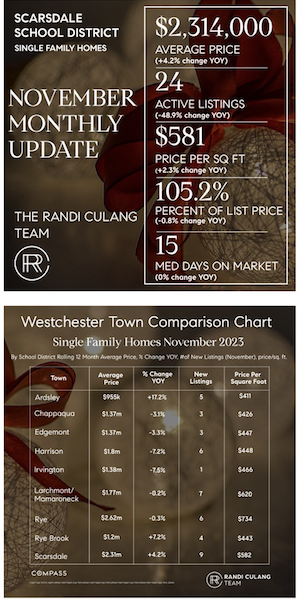
Jack Miller of 45 Fayette Road offered contradictory evidence to the claim that the moratorium would decrease home values. He said, “A few years ago there was a movement to preserve Larchmont and they enacted a 6-month moratorium to allow time to holistically evaluate the stormwater code, tree laws, lot coverage and soils and excavation. They added a pre-submission conference for applicants. … We could use what they did as a playbook for the community. It allowed for the preservation of their entry level homes. When Larchmont unveiled the new laws both sides were unhappy which means both sides had compromised. Today homes in Larchmont are selling for $620 per square foot as compared to $582 per square foot in Scarsdale and the woman who led the moratorium, Sarah Bauer, is now the town’s Mayor.”
Helen Maccarino of Cushman Road said, “I am concerned about development in sensitive drainage areas. A moratorium would allow us to redo the code about what is built in the wetlands. They manage stormwater runoff. Parts of Scarsdale are soggy. It is not unusual to find water just 2 or 3 feet below the surface. You can’t put a cultec in a place where it will fill up immediately. This will allow us to reconsider variance proposals to encroach into wetlands that will have a significant impact. We can consider our infrastructure. I believe a moratorium would allow us to view the big picture.”
Lisa McIver from Branlee Heights said, “We have had overbuilding, overbuilding, over-building. The foundations of the new houses are all raised to create problems. They took down 5 homes and built 11 on Brambach. There must be consideration of the water problem… everyone is flooding.
Cynthia Roberts of 15 Autenreith Road said she has lived here for 24 years and her home is 112 years old. She said, “We consider it a privilege and invest heavily in maintaining the charm of Old Scarsdale. I am always looking for a carpenter or a plumber.”
To those who asked for incremental changes she said, “This is not normal. Our climate is changing faster than we ever imagined. We are hearing about residents’ homes flooding again again and again. One man couldn’t even go on vacation. The Village Engineer said if we spend $3-$12 mm this would not guarantee that there would not be flooding. It is already impacting the health and safety of our community… We need to step up and act as a community. I think misinformation has been spread. A lot of work could still be done.”
Claire Hunt of 44 Carman Road called and exclaimed, “So many builders and architects only work in Scarsdale? I think it shows what a building problem we have! I live in a small home – just 1,700 square feet. There are no small modest homes left in Scarsdale. The builders snap up the more modest homes, tear them down and build a home at three times the value. People don’t have the chance to come here and put in the sweat equity. We need to encourage people to renovate these greener homes. We need to work with what we have. Let these builders renovate these older homes.”
Jim Detmer of Woods Lane who started the petition for the moratorium said, “Houses are being built without regard to space, land use and aesthetic value. We are about to have a village of large white boxes on small lots. There are also the stormwater issues. In Edgewood there is raw sewage in some of our homes. One major ally in fighting stormwater is trees – this needs to be addressed. The moratorium provides the space and time to address these critical issues. Please discuss, draft and act on legislation that addresses the needs and values of Scarsdale.”
At the conclusion of the hearing, Mayor Justin Arest said, “I am in favor of the zoning and building code review. The iterative approach has not been effective. I am in favor of discussing a more limited moratorium. We are already moving forward on the land use review.” He added, “No decision has been made. I would encourage you to share your ideas on how to limit the moratorium should it proceed to have the least amount of impact for the most positive outcome.”
In response to speaker Adrienne Price who suggested that the trustee’s views might be affected by where they live, Trustee Karen Brew said, “We represent all of Scarsdale and we are trying to do what is best for the entire community. We factor in what we heard.”














